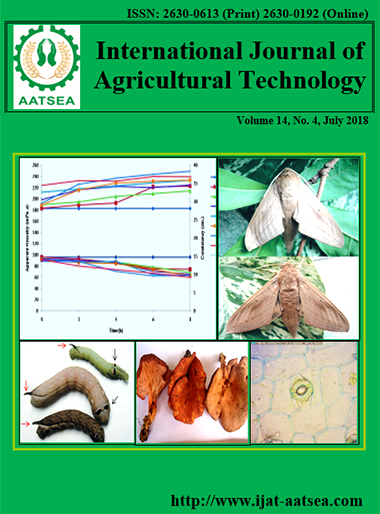Product Development of Sweet Fermented Rice (Khoa-Mak) Supplemented with Red Yeast Rice
Main Article Content
Abstract
A new healthy food product, sweet fermented glutinous rice (Khoa-Mak) supplemented with red yeast rice was developed in this study. Significant source of Loop-Pang (rice starter culture) for Khoa-Mak fermentation were investigated, and effect of supplementation of red yeast rice on quality of Khoa-Mak during storage was further carried out. Total soluble solid (TSS), pH, ethanol content, yeast and mold, total viable count, Escherichai coli, sensory evaluation of sample were determined. Glutinous rice was fermented with various sources of Loog-Pang (Chachoengsao, Chanthaburi, Trad and Prachinburi) at 30°C for 72 hours. Microbial populations in various Loog-Pang sources increased rapidly during fermentation. Rice fermented by Loog-Pang sources from Trad for 48 hours had the highest sensory acceptability by elderly consumers, and contained 0.12% of ethanol, 40°Brix of TSS, pH of 4.2 and less than 3 MPN/g of E. coli. During storage at 4°C for 2 weeks, microbial populations survived at low pH in Khoa-Mak (without red yeast rice, and supplemented with 0.1, 0.2 and 0.3% of red yeast rice). The supplementation of red yeast rice from 0 to 0.3% resulted in the increasing of Monascus pigments concentrations and antioxidative properties in Khoa-Mak (p<0.05). Sensory scores of Khoa-Mak supplemented with 0.3% of red yeast rice were higher than those for other samples, except Khoa-Mak without red yeast rice (p<0.05). The results indicated that Khoa-Mak supplemented with 0.3% of red yeast rice could be a new healthy food product, particularly for elderly consumers.
Article Details

This work is licensed under a Creative Commons Attribution-NonCommercial-NoDerivatives 4.0 International License.
References
Amerine, M. A. and Ough, C. S. (1974). Wine and must analysis. New Jersey: John Wiley and Sons, Inc.
Carvalho, J. C., Pandey, A., Babitha, S. and Soccol, C. R. (2003). Production of Monascus biopigments. Agro Food Industry Hi Tech 14:37-41.
Feng, Y., Shao, Y. and Chen, F. (2012). Monascus Pigments. Applied Microbiology and Biotechnology 96:1421-1440.
Hsu, L. C., Liang, Y. H., Hsu, Y. W., Kuo, Y. H. and Pan, T. M. (2013). Anti-inflammatory properties of yellow and orange pigments from Monascus purpureus NTU 568. Journal of Agricultural and Food Chemistry 61:2796.
Jirasatid, S., Nopharatana, M., Kitsubun, P. and Tongta, A. (2013). Degradation kinetics of monacolin K in red yeast rice powder using mutiresponse modeling approach. Journal of Food Engineering 116:436-443.
Johns, M. R. and Stuart, D. M. (1991). Production of pigment by Monascus purpureus in solid culture. Journal of Industrial Microbiology and Biotechnology 8:23-28.
Khamkeaw, A. and Phisalaphong, M. (2016). Hydrolysis of cassava starch by co-immobilized multimicroorganisms of Loog-Pang (Thai rice cake starter) for ethanol fermentation. Food Science and Biotechnology 25:509-516.
Lee, C. L., Hung, Y. P., Hsu, Y. W. and Pan, T. M. (2013). Monascin and ankaflavin have more anti-atherosclerosis effect and less side effect involving increasing creatinine phosphokinase activity than monacolin K under the same dosages. Journal Agricultural and Food Chemistry 61:143-150.
Lee, C. L., Wang, J. J., Kuo, S. L. and Pan, T. M. (2006). Monascus fermentation of dioscorea for increasing the production of cholesterol-lowering agent-monacolin K and antiinflamation agent-monascin. Applied Microbiology and Biotechnology 72:1254-1262.
Ministry of Industry (2013). Thai Community Product Standard (TCPS) of sweet fermented glutinous rice. Document of TCPS No. 162/2013. Thai Industrial Standards Institute (TISI), Bangkok.
Manosroi, A., Ruksiriwanich, W., Kietthanakorn, B., Monosroi, W and Monosroi J. (2011). Relation between biological activities and bioactive compounds in the fermented rice sap. Food Research International 44:2757-2765.
Mongkontanawat, N. and Lertnimitmongkol, W. (2015). Product development of sweet fermented rice (Khao-Mak) from germinated native black glutinous rice. International Journal of Agricultural Technology 11:501-515.
Nagpal, R., Kumar, A., Kumar, M., Behare, P. V., Jain, S. and Yadav, H. (2012). Probiotics, their health benefits and applications for developing healthier food: a review. FEMS. Microbiology Letters 334:1-15.
Plaitho, Y., Kangsadalampai, K. and Sukprasansap, M. (2013). The protective effect of Thai fermented pigmented rice on urethane induced somatic mutation and recombination in drosophila melanogaster. J Medicinal Plants Research 72:91-98.
Su, Y. C., Lin, Y. L., Lee, M. H. and Ho, C. Y. (2005). Ankaflavin from Monacus fermented red yeast rice exhibits selective cytotoxic effects and increase cell death on HepG2 cells. Journal Agricultural and Food Chemistry 53:1949-1954.
Tochampa, W., Jittrepotch, N., Kongbangkerd, T., Kraboun, K. and Rojsuntornkitti, K. (2011). The study of microwave heating time on chemical and microbiological properties and sensory evaluation in sweet fermented glutinous rice (Khao-Mark). International Food Research Journal 18:239-248.
Yousef, A. E. and Carlstrom, C. (2003). Food Microbiology: A Laboratory Manual. New Jersey: John Wiley and Sons, Inc.


